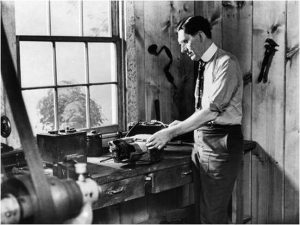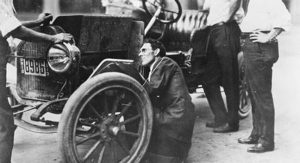By Matt Wolfe
April 17, 1911, Charles Kettering Applies for a United States Patent for his electric vehicle starter
Though it has been in use for over a century, the electric vehicle starter is still an important component in every modern automobile. An invention of Hall of Fame Inductee Charles Kettering, the electric starter eliminated the need for a crank handle to manually start early automobiles and quickly became compulsory equipment on vehicles all over the world.
Kettering’s invention of the self-starter came at the request of fellow Hall of Fame Inductee Henry Leyland, the founder of Cadillac. Like all cars of the period, Cadillacs required the use of a hand crank to start. There was an inherent danger in this method; if the engine’s spark timing was not properly set, it could backfire and cause the handle to kick back and inflict serious injury.

Kettering in his workshop in Ohio. Photo courtesy of the Automotive Hall of Fame Archives
During the winter of 1908, a friend of Leland’s, Byron Carter, was killed while attempting to start a Cadillac automobile for a stranded motorist on Belle Isle in Detroit, Michigan. The driver forgot to adjust the spark, and the motor backfired, causing its crank handle to strike and break Carter’s jaw. Carter later died of pneumonia and other complications resulting from the incident. Upon hearing of his friend’s death, Leyland proclaimed, “The Cadillac car will kill no more men if we can help it!” He immediately set his engineers to work on developing a means of starting a vehicle by utilizing an electric motor.
They were successful, but the contraption they had devised was too large for automotive use. The task then fell to Kettering and his team at Dayton Engineering Laboratories (or “Delco”) to refine the concept. Kettering and his team worked tirelessly to perfect their electric starter over the next three years. They presented their final design to Leland in 1911, who approved it for production on the 1912 Cadillac.

Charles Kettering (kneeling center) installing his electric starter in an early Buick automobile. Photo courtesy of the Automotive Hall of Fame Archives
Kettering’s company would be responsible for numerous automotive engineering innovations, and was sold to General Motors in 1918. It became the foundation for GM’s Research Laboratory, of which Kettering was named vice-president in 1920 and remained in that position for 27 years. In 1998, the General Motors Institute of Flint, Michigan, renamed itself Kettering University in honor of Kettering’s contributions. A talented inventor and engineer, Charles Kettering helped jumpstart the evolution of the automobile.